Latest update 20 January 2007
The design work on the H-4 helmet appears to have started late 1952 or early 1953. By
late 1953 its development has progressed so far that it was offered to the Royal
Australian Air Force as part of their helmet acquisition programme. It is not fully clear
when the H-4 entered US Navy service but 1954 appears to be a good guess.
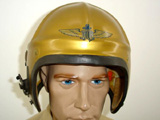
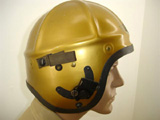
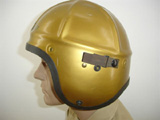
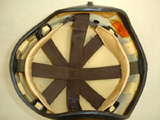
ment straps you can see the studs for attaching goggles. Pictures © Peter Bennethum "flightjkt"
I have not seen any reports on the H-3 shortcomings that
led to the development of the H-4, but the following brief description of the H-4 helmet
from a US Navy training manual from around 1960 indirectly indicate what they were. The
training manual mentioned that the H-4 helmet is basically the same as the H-3 with the
following exceptions:
1. The headband is fixed in front and is not adjustable.
2. The front of the helmet has been lowered for increased protection and stability.
3. The center panel of the H-4 liner is made of nylon mesh for coolness.
4. The stability of the H-4 protective helmet is an improvement over the H-3; however, the
stabilizing straps omitted on the H-4 may be added when requested.
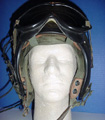
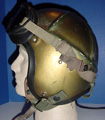
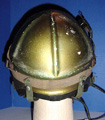
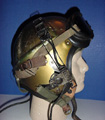
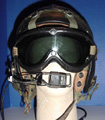
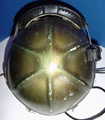
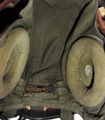
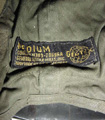
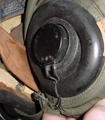
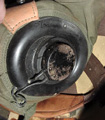
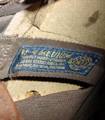
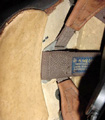
Top row: H-4 helmet fitted with stabilising
straps and goggles with long strap going all the way around the helmet.
The picture to the far right shows the large elevated area where the six reinforcing
ridges meet on the crown of the
helmet - a very typical feature of the H-4 helmet. Bottom far left and middle
left: Early H-4 inner liner without
the later mesh panels in the middle. Bottom centre left and centre
right: H-87A/U earphones. Bottom right:
Woven Gentex label on the head sling. Bottom far right: Detail of the
head sling attachment. Pictures © arklight1
It suggests that the H-3 helmet did not offer sufficient
protection from a hard head-on blow, the lack of protection being caused by a combination
of an adjustable headband that was not stable enough and a shell that did not cover enough
of the forehead. The nylon mesh centre panel on the inner liner was a late addition to the
H-4; the first liners only differed from the H-3 inner liner by having two male studs on
each side for attachment of oxygen masks with Pull-the-Dot fasteners, whereas the H-3
liner had three male studs on each side of the same type as used by the USAF. The attempt
to design the H-4 with improved stability over the H-3 do not appear to have been
particularly successful. The modification with the stabilising straps appears to have been
widely applied to the H-4, which became the standard anti-buffet helmet from around 1954
onwards.
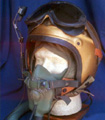
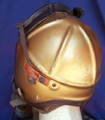
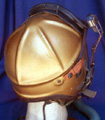
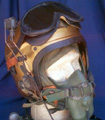
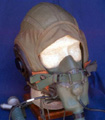
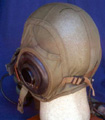
H-4 fitted with an A-13A oxygen mask. The inner liner is of
the late model with mesh panels over the crown. This
helmet has not been fitted with stabilising straps. It is equipped with the USN standard
goggles attached with snaps
to studs on each side of the helmet. Pictures © Maggot
The H-3 and H-4 continued side by side as a sort of
Duke's mixture of H-4s and H-3s having H-4 liners. From late 1956 the APH-5 helmet became
the primary helmet for high performance aircraft so the H-3 and H-4 were relegated to less
glorious use. Both the H-3 and the H-4 were still mentioned in the 1964-dated NAVPERS
10358-B PR training manual. By that time the H-3 and H-4 helmets were primarily used by
crewmen in multi-place aircraft. They were no longer under procurement; and when
replacement was necessary, they would be replaced by either the SPH-2, the BPH-2, or one
of the APH types, whichever was applicable. The H-3 and H-4 were no longer mentioned in
the 1967-dated NAVPERS 10358-C. It may therefore safely be assumed that for all intents
and purposes the H-3 and H-4 disappeared from USN service between 1964 and 1967.
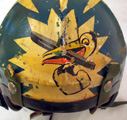
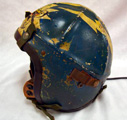
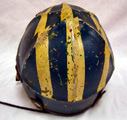
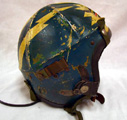
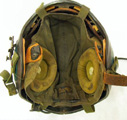
Pictures of an H-4 with artwork from Anti-Submarine Warfare
Squadron 27 (VS-27). Far right: When H-3 and H-4
helmets were modified with stabilisation straps users often left the hardshell and the
inner liner snapped together.
In this way the helmet was akin to an integrated helmet. Pictures © snappyauctions14.
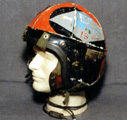
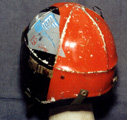
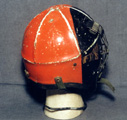
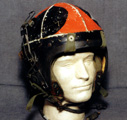
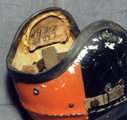
H-4 helmet with artwork from an unidentified unit. The name
of the owner, Larry Ziehm, is written in grease pencil
on the right hand side pad. Apparently the owner did his own artwork. At least the grey
rhombus with the blue bird
is signed 'Larry' along the lower right hand edge. Picture © Bluelight
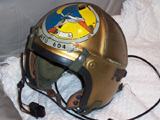
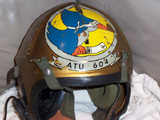
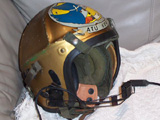
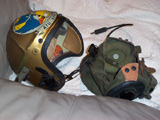
H-4 helmet with an Advanced Training Unit (ATU) 604 squadron badge. Judging from the
blind-folded bird on the badge it might be an all-weather, instrument flying training unit. Pictures © Unknown
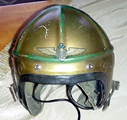
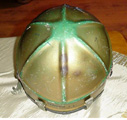
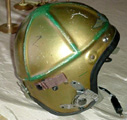
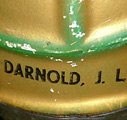
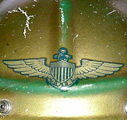
H-4 helmet named to a J.L. Darnold. It is showing the very
typical green fading that appears in the gold paintwork
after some years of use and wear. The natural metal microphone mount seen in the middle
picture is unusual. Most
helmets have blackened mounts. Pictures © jstlook777